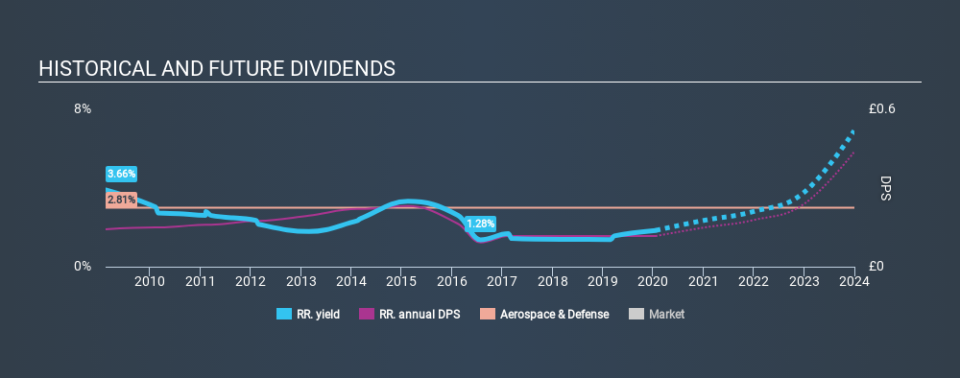Are Dividend Investors Making A Mistake With Rolls-Royce Holdings plc (LON:RR.)?

Could Rolls-Royce Holdings plc (LON:RR.) be an attractive dividend share to own for the long haul? Investors are often drawn to strong companies with the idea of reinvesting the dividends. Yet sometimes, investors buy a stock for its dividend and lose money because the share price falls by more than they earned in dividend payments.
A slim 1.7% yield is hard to get excited about, but the long payment history is respectable. At the right price, or with strong growth opportunities, Rolls-Royce Holdings could have potential. Some simple analysis can reduce the risk of holding Rolls-Royce Holdings for its dividend, and we'll focus on the most important aspects below.
Click the interactive chart for our full dividend analysis
Payout ratios
Dividends are usually paid out of company earnings. If a company is paying more than it earns, then the dividend might become unsustainable - hardly an ideal situation. So we need to form a view on if a company's dividend is sustainable, relative to its net profit after tax. Although Rolls-Royce Holdings pays a dividend, it was loss-making during the past year. When a company recently reported a loss, we should investigate if its cash flows covered the dividend.
Rolls-Royce Holdings paid out 62% of its free cash flow last year, which is acceptable, but is starting to limit the amount of earnings that can be reinvested into the business.
While the above analysis focuses on dividends relative to a company's earnings, we do note Rolls-Royce Holdings's strong net cash position, which will let it pay larger dividends for a time, should it choose.
Remember, you can always get a snapshot of Rolls-Royce Holdings's latest financial position, by checking our visualisation of its financial health.
Dividend Volatility
Before buying a stock for its income, we want to see if the dividends have been stable in the past, and if the company has a track record of maintaining its dividend. For the purpose of this article, we only scrutinise the last decade of Rolls-Royce Holdings's dividend payments. The dividend has been cut on at least one occasion historically. During the past ten-year period, the first annual payment was UK£0.14 in 2010, compared to UK£0.12 last year. This works out to be a decline of approximately 2.0% per year over that time. Rolls-Royce Holdings's dividend has been cut sharply at least once, so it hasn't fallen by 2.0% every year, but this is a decent approximation of the long term change.
We struggle to make a case for buying Rolls-Royce Holdings for its dividend, given that payments have shrunk over the past ten years.
Dividend Growth Potential
Given that the dividend has been cut in the past, we need to check if earnings are growing and if that might lead to stronger dividends in the future. Over the past five years, it looks as though Rolls-Royce Holdings's EPS have declined at around 14% a year. A sharp decline in earnings per share is not great from from a dividend perspective, as even conservative payout ratios can come under pressure if earnings fall far enough.
Conclusion
To summarise, shareholders should always check that Rolls-Royce Holdings's dividends are affordable, that its dividend payments are relatively stable, and that it has decent prospects for growing its earnings and dividend. We're not keen on the fact that Rolls-Royce Holdings paid dividends despite reporting a loss over the past year, although fortunately its dividend was covered by cash flow. Earnings per share are down, and Rolls-Royce Holdings's dividend has been cut at least once in the past, which is disappointing. There are a few too many issues for us to get comfortable with Rolls-Royce Holdings from a dividend perspective. Businesses can change, but we would struggle to identify why an investor should rely on this stock for their income.
Without at least some growth in earnings per share over time, the dividend will eventually come under pressure either from costs or inflation. See if the 15 analysts are forecasting a turnaround in our free collection of analyst estimates here.
We have also put together a list of global stocks with a market capitalisation above $1bn and yielding more 3%.
If you spot an error that warrants correction, please contact the editor at editorial-team@simplywallst.com. This article by Simply Wall St is general in nature. It does not constitute a recommendation to buy or sell any stock, and does not take account of your objectives, or your financial situation. Simply Wall St has no position in the stocks mentioned.
We aim to bring you long-term focused research analysis driven by fundamental data. Note that our analysis may not factor in the latest price-sensitive company announcements or qualitative material. Thank you for reading.

 Yahoo Finance
Yahoo Finance 
